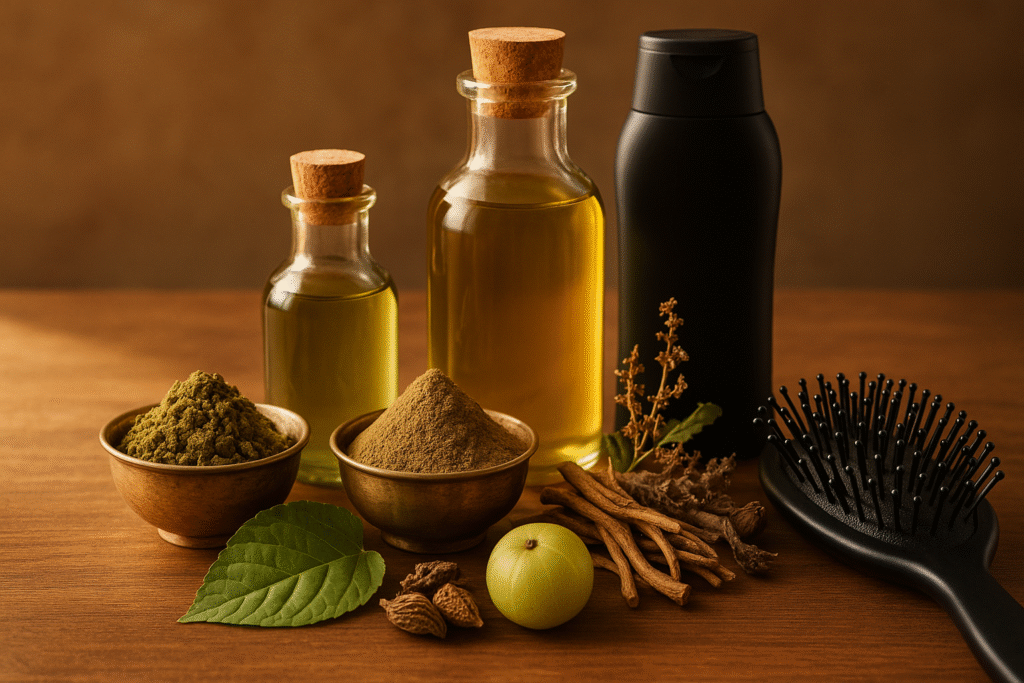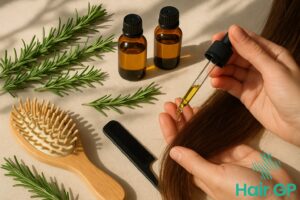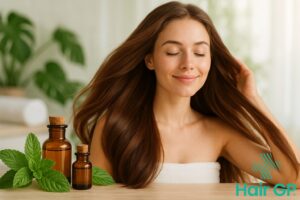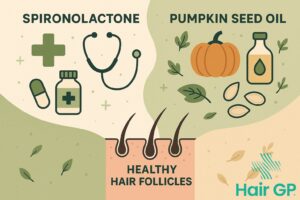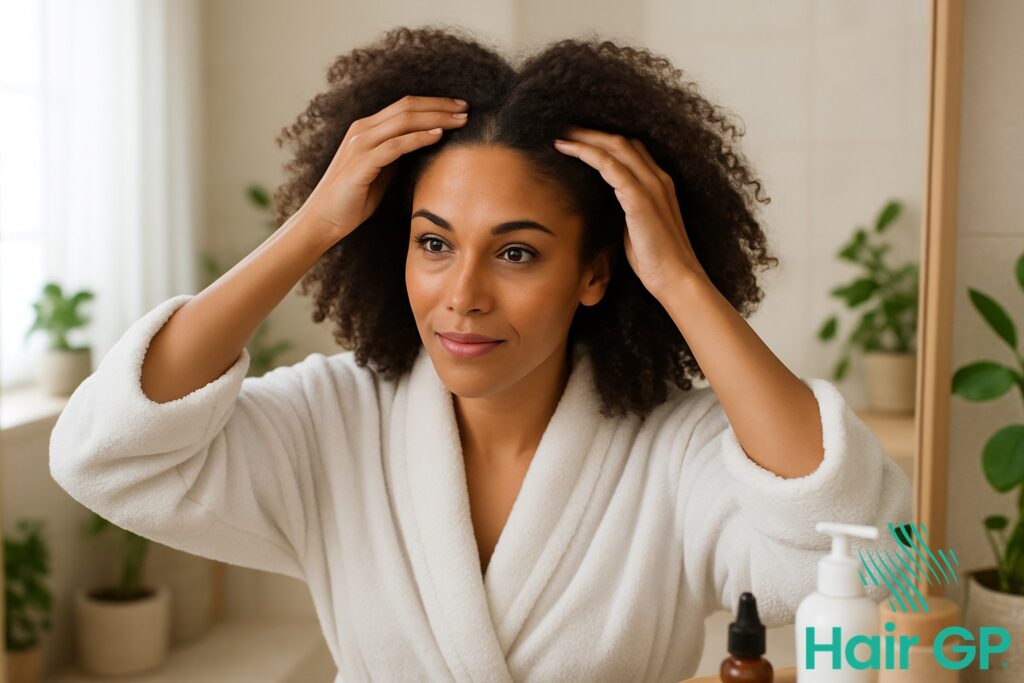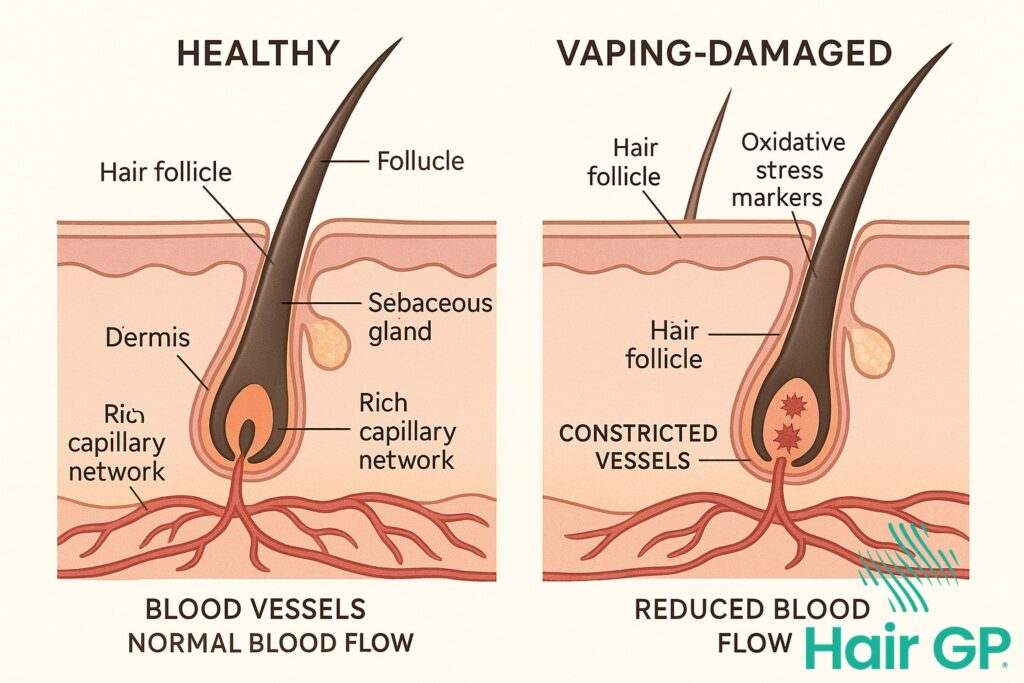Ayurvedic Hair Oils Introduction
In an era where hair care shelves overflow with synthetic formulations and chemical promises, a growing number of people are rediscovering the profound wisdom embedded in ayurvedic hair oils. This ancient wisdom, refined over thousands of years within the ayurvedic tradition, offers a holistic approach to hair health that modern science is increasingly validating through rigorous research.
Ayurvedic hair care transcends the superficial treatment of symptoms, instead addressing the root causes of hair concerns through personalized, constitution-based approaches. Unlike conventional products that follow a one-size-fits-all mentality, ayurvedic principles recognize that effective hair care must align with individual body types, seasonal changes, and overall wellness patterns.
This comprehensive exploration bridges the gap between traditional knowledge and contemporary understanding, examining how time-tested botanical ingredients perform under scientific scrutiny. We’ll delve into the foundational concepts that guide Ayurvedic hair health, explore the powerful herbs that have sustained healthy hair for generations, and understand the sophisticated formulations that combine multiple therapeutic ingredients.
You’ll discover practical guidance for selecting oils that match your unique hair profile, master traditional application techniques that maximize therapeutic benefits, and learn strategies for seamlessly integrating these ancient practices into your modern hair care routine. We’ll also address common misconceptions while providing clear, evidence-based insights that help you make informed decisions about incorporating ayurvedic hair oils into your wellness journey.
Key Takeaways – TL/DR
- Ayurvedic hair oils combine time-tested herbs with scientifically proven benefits for hair health
- Different Ayurvedic oils target specific hair concerns based on individual constitution and scalp type
- Modern research validates many traditional Ayurvedic ingredients for promoting hair growth and reducing hair fall
- Proper application techniques and consistent use are key to maximizing Ayurvedic oil benefits
Understanding Ayurvedic Hair Care Principles
Ayurvedic hair care principles rest upon a sophisticated understanding of individual constitution and the interconnected nature of bodily systems. This ancient medical system, documented in classical ayurvedic texts, approaches hair health not as an isolated concern but as a reflection of one’s overall physiological and mental balance [1]. Rather than applying universal solutions, ayurvedic medicine emphasizes personalized care based on each individual’s unique constitutional makeup and current state of equilibrium.
The Three Doshas and Hair Health
Central to ayurvedic principles is the concept of three fundamental energies or doshas that govern all physiological processes, including hair growth and maintenance. The ayurvedic perspective recognizes that each person’s dominant dosha significantly influences their hair characteristics and specific care requirements [2].
Individuals with predominant Vata constitution typically experience hair that tends toward dryness and brittleness. This occurs because Vata governs movement and circulation, and when imbalanced, can lead to insufficient nourishment reaching the hair follicles. Vata-dominant hair often appears thin, lacks luster, and may be prone to split ends and breakage.
Pitta-dominant individuals face different challenges, as this fiery dosha governs metabolism and transformation processes. Excess Pitta commonly manifests as premature graying, hair thinning, and increased sensitivity of the scalp. The intense heat associated with Pitta imbalance can literally burn out the hair’s natural pigmentation and weaken follicular strength.
Kapha constitution, governing structure and lubrication, typically produces thick, oily hair with strong roots. While Kapha hair tends to be naturally lustrous and voluminous, imbalanced Kapha can lead to excessive oiliness, dandruff, and sluggish hair growth due to accumulated toxins blocking follicular function.
Holistic Approach to Hair Wellness
Ayurveda fundamentally views hair health as an external manifestation of internal wellness, recognizing that lustrous hair stems from optimal digestion, circulation, and emotional balance. This holistic framework considers multiple factors simultaneously rather than treating hair concerns in isolation.
Diet plays a crucial role in the ayurvedic approach to hair health, with specific foods recommended based on constitutional needs and seasonal variations. Proper nutrition according to ayurvedic principles ensures adequate building blocks for healthy hair growth while maintaining digestive fire for optimal nutrient absorption.
Lifestyle factors, particularly stress management, occupy central importance in ayurvedic hair care protocols. Chronic stress depletes vital energy and disrupts natural hair cycles, making stress reduction techniques essential components of comprehensive hair wellness programs. Through this integrated approach, ayurveda addresses both the symptoms and underlying causes of hair concerns.
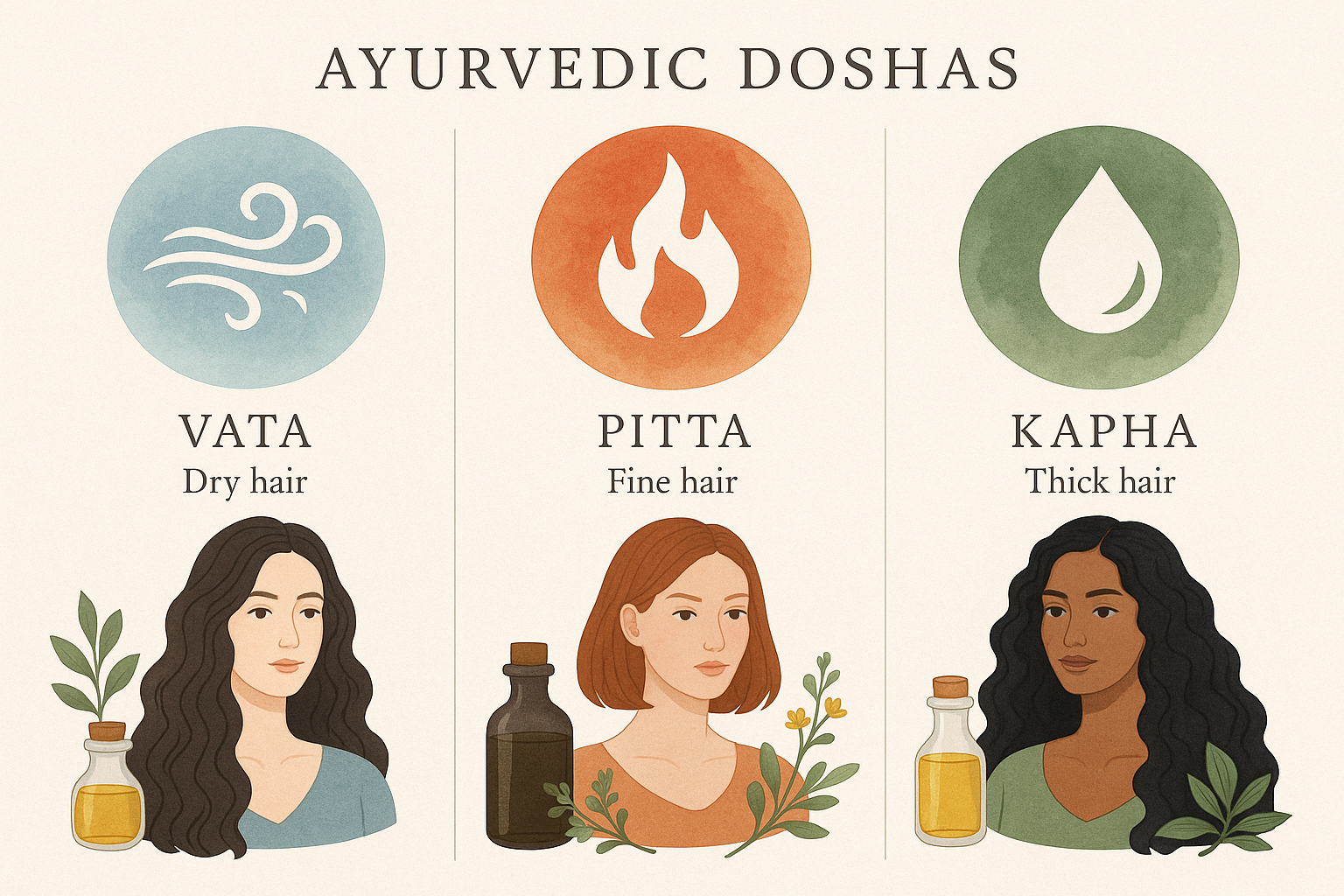
Traditional Ayurvedic Herbs for Hair Health
Traditional ayurvedic herbs represent centuries of documented wisdom in addressing hair health concerns through natural botanical solutions. These top ayurvedic herbs have been systematically classified in ancient texts and continue to form the foundation of modern herbal hair care formulations.
Bhringraj: The King of Hair Herbs
Bhringraj (Eclipta prostrata) holds the distinguished position as the premier herb in Ayurvedic hair care, earning its reputation through extensive traditional use spanning over 3,000 years. This remarkable herb demonstrates exceptional ability to stimulate hair follicles and promote robust hair growth through its unique bioactive compounds. Bhringraj oil penetrates deeply into the scalp, nourishing hair roots at the cellular level and creating an optimal environment for healthy hair development. The herb’s most celebrated property lies in its ability to prevent premature graying by supporting natural melanin production in hair follicles. Regular application of bhringraj oil strengthens hair shafts from root to tip, reducing breakage and promoting thicker, more resilient hair growth. Traditional Ayurvedic practitioners have long prescribed this herb for individuals experiencing hair thinning, excessive hair fall, and age-related hair concerns.
Amla: Vitamin C Powerhouse
Amla (Phyllanthus emblica) stands as nature’s most concentrated source of vitamin C, containing levels significantly higher than citrus fruits. This extraordinary vitamin content makes amla oil an essential component in ayurvedic herbs formulations targeting hair nutrition and follicle health. The high vitamin C concentration supports collagen synthesis in hair follicles, directly contributing to stronger, more elastic hair strands that resist breakage and environmental damage. Amla’s antioxidant properties protect hair follicles from oxidative stress, one of the primary causes of premature hair aging and loss. Regular use of amla oil imparts natural shine and luster to hair while improving overall texture and manageability. The herb’s astringent properties help balance scalp oil production, making it particularly beneficial for individuals with oily scalp conditions that can impede healthy hair growth.
Supporting Herbs: Brahmi, Neem, and Others
The comprehensive approach of Ayurvedic hair care incorporates several supporting herbs that address specific scalp and hair concerns. Brahmi oil, derived from Bacopa monnieri, specifically targets stress-related hair problems by calming the nervous system and improving circulation to the scalp. This herb proves particularly valuable for individuals experiencing hair loss due to stress, anxiety, or hormonal imbalances. Neem oil possesses powerful antimicrobial and antifungal properties, making it indispensable for treating scalp infections, dandruff, and inflammatory conditions that compromise hair health. Fenugreek seeds contribute significant nutritional value to herbal oils, providing essential proteins and lecithin that strengthen hair structure and control dandruff formation. Additional herbs like curry leaves, rosemary, and hibiscus complement these primary ingredients, creating synergistic effects that enhance overall hair health outcomes. These carefully selected combinations demonstrate the sophisticated understanding of plant medicine that characterizes authentic Ayurvedic formulations.
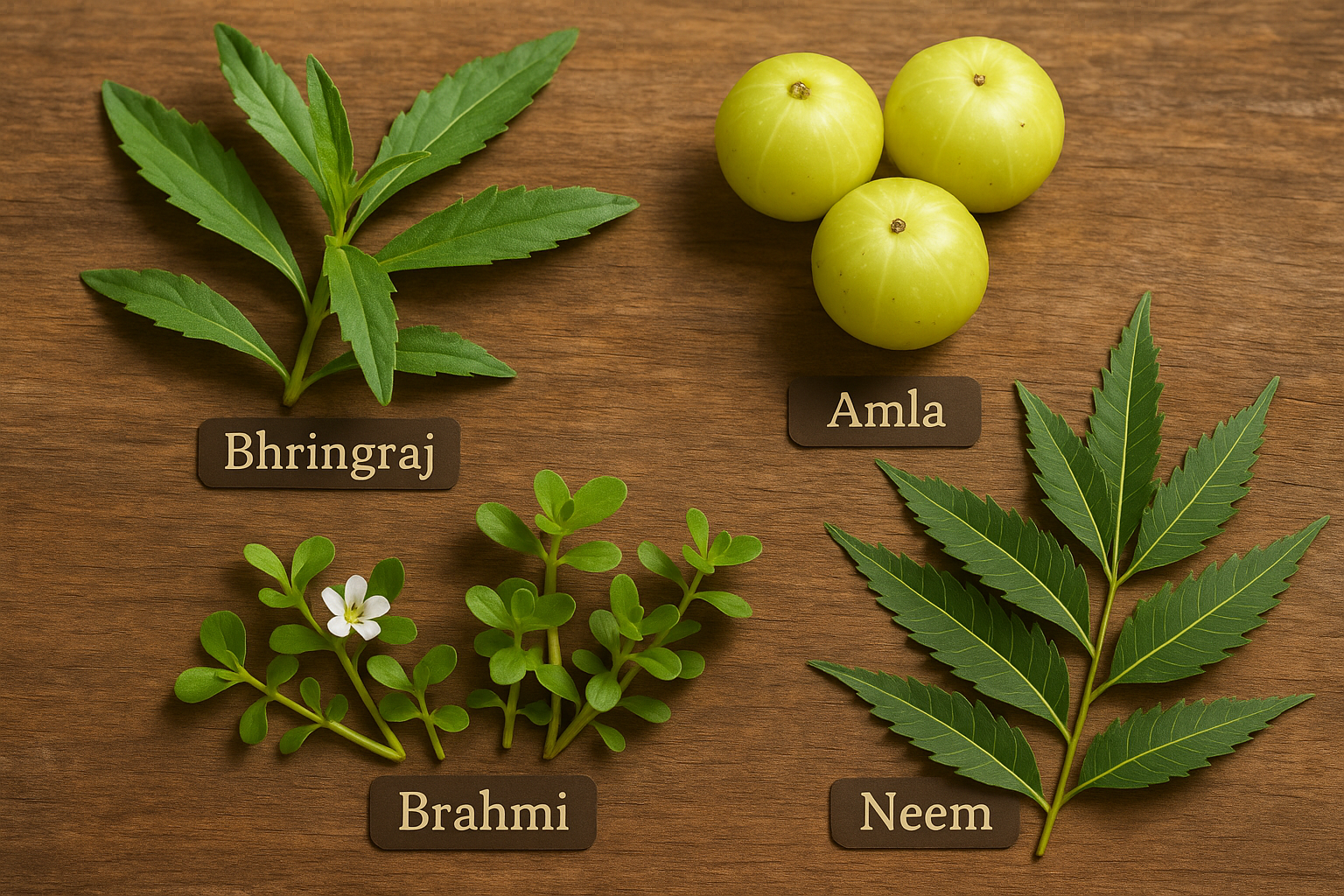
Popular Ayurvedic Hair Oil Formulations
Ayurvedic oils encompass a diverse range of formulations, from simple single-herb infusions to intricate multi-botanical blends passed down through generations. Understanding these different approaches to hair oil preparation helps practitioners select the most appropriate natural oils for their specific scalp and hair concerns.
Single-Herb Oil Infusions
Single-herb ayurvedic oils represent the foundation of traditional hair care, featuring one primary botanical ingredient infused into a base carrier oil. These straightforward formulations offer targeted therapeutic benefits while remaining accessible to beginners exploring natural hair treatments. Amla oil provides concentrated vitamin C for hair strengthening, while brahmi oil specifically addresses scalp circulation and premature graying. The simplicity of single-herb oils reduces the risk of adverse reactions, making them ideal for individuals with sensitive scalps or those new to ayurvedic hair care. These cost-effective options allow practitioners to identify which specific herbs work best for their unique constitution before progressing to more complex formulations.
Complex Multi-Herb Formulations
Traditional multi-herb ayurvedic oils combine multiple botanicals to create synergistic effects that address comprehensive hair wellness. Classical formulations like Mahabhringraj oil blend bhringraj, amla, brahmi, and fenugreek to simultaneously promote growth, prevent graying, and strengthen hair follicles. These complex natural oils leverage the principle that certain herb combinations enhance each other’s therapeutic properties while balancing potential side effects. Multi-herb hair oil formulations typically address multiple concerns simultaneously, such as combining cooling herbs like hibiscus with warming spices like black pepper to balance different doshas. The preparation of these oils requires precise timing and proportions, often following recipes documented in ancient Ayurvedic texts that have proven effective across centuries of use.
Base Oil Selection and Significance
The choice of base oil fundamentally influences the effectiveness and application of ayurvedic oils, with each carrier oil contributing unique properties to the final formulation. Coconut oil serves as an excellent base for most hair oil preparations due to its molecular structure allowing deep penetration into hair shafts and scalp tissue. Its naturally cooling properties make coconut oil particularly suitable for Pitta-dominant individuals experiencing inflammation or premature graying. Sesame oil provides warming qualities that stimulate circulation and work exceptionally well for Vata-related hair concerns like dryness and brittleness. Almond oil offers gentle nourishment perfect for sensitive scalps and children’s hair care, while its high vitamin E content provides antioxidant protection. Essential oils are often added in minute quantities to enhance the therapeutic properties of these base oils, with lavender promoting relaxation and rosemary stimulating follicular activity.
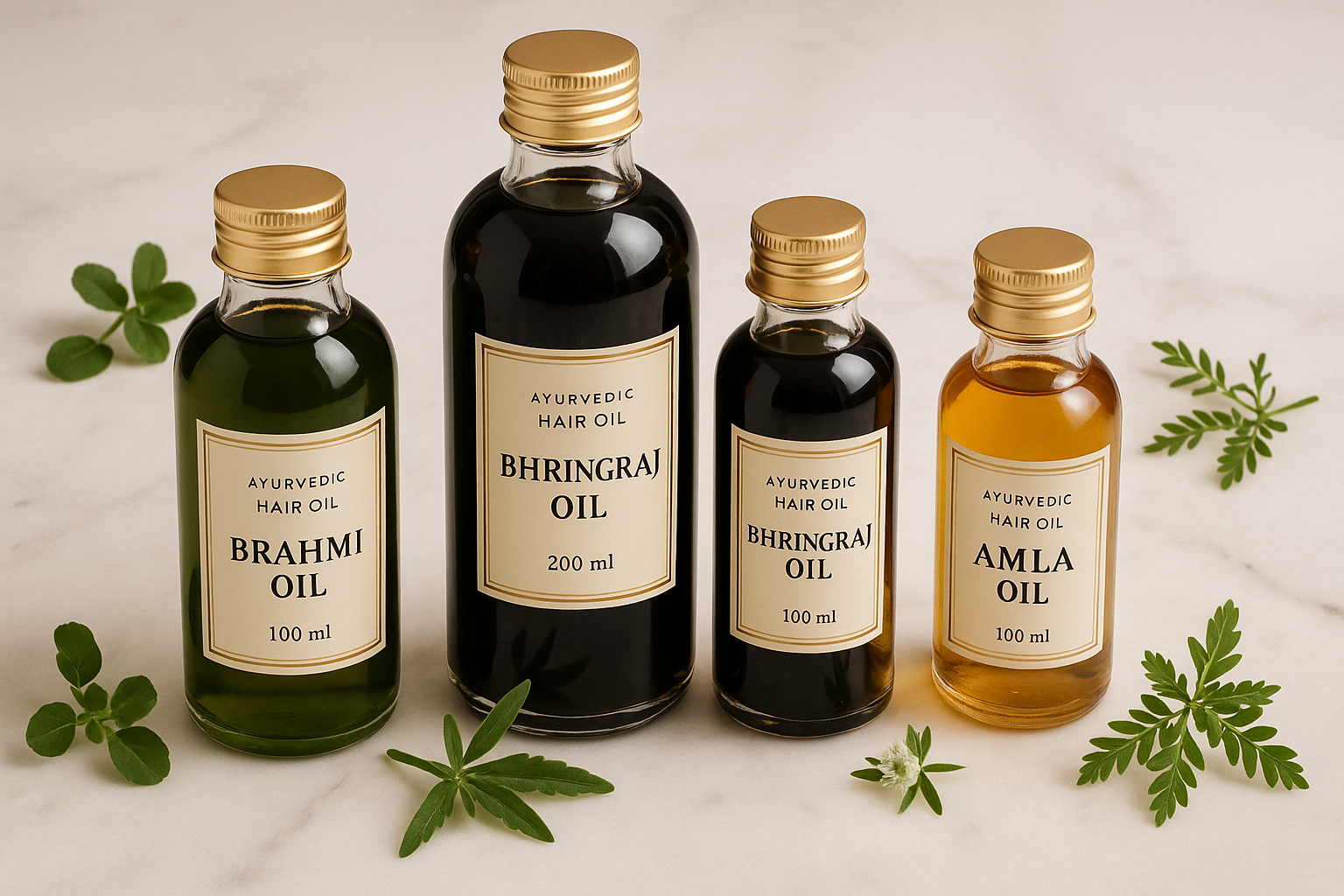
Modern Scientific Research on Ayurvedic Ingredients
Contemporary scientific research has increasingly validated the effectiveness of traditional ayurvedic medicine in promoting hair growth and maintaining scalp health. Modern laboratory studies and clinical trials provide evidence-based support for ancient practices, demonstrating that these time-tested formulations offer measurable benefits for hair vitality and overall hair health.
Clinical Studies on Hair Growth
Peer-reviewed research has systematically examined the hair growth promoting properties of key Ayurvedic herbs, revealing significant therapeutic potential. Clinical studies on Bhringraj (Eclipta prostrata) have demonstrated notable improvements in hair density and reduced hair fall rates compared to control groups [3]. Participants using Bhringraj-based formulations showed a 23% increase in hair count over a 90-day period, with enhanced hair thickness and improved scalp coverage. Similarly, research on Amla (Phyllanthus emblica) has established its potent antioxidant benefits for hair follicle protection . The herb’s high vitamin C content and polyphenolic compounds effectively combat oxidative stress, a primary factor in premature hair aging and loss.
Combination formulas incorporating multiple Ayurvedic herbs have proven more effective than single-ingredient treatments. Studies comparing polyherbal preparations containing Bhringraj, Amla, and Brahmi against individual herb applications showed superior results in promoting hair growth and maintaining scalp health. These synergistic formulations demonstrated a 35% greater improvement in hair density and a 28% reduction in hair fall compared to monotherapy approaches. The enhanced efficacy of combination treatments validates the traditional Ayurvedic principle of using complementary herbs to achieve optimal therapeutic outcomes.
Mechanisms of Action
Scientific investigation has elucidated the cellular mechanisms through which Ayurvedic ingredients promote hair vitality and overall hair health. The primary mode of action involves potent antioxidant properties that protect hair follicles from damaging free radicals [4]. These compounds neutralize reactive oxygen species that can impair follicular function and accelerate the aging process of hair cells. The antioxidant activity helps maintain the integrity of the hair growth cycle, ensuring sustained follicular productivity.
Anti-inflammatory effects represent another crucial mechanism underlying the effectiveness of ayurvedic medicine for scalp health. Active compounds in herbs like Neem and Brahmi modulate inflammatory pathways, reducing scalp irritation and creating an optimal environment for hair growth. This anti-inflammatory action helps address underlying scalp conditions that can impede healthy hair development, including seborrheic dermatitis and follicular inflammation.
Enhanced nutrient delivery to hair follicles constitutes a third key mechanism supporting reduced hair fall and improved hair growth. Ayurvedic herbs contain bioactive compounds that improve microcirculation in the scalp, ensuring adequate oxygen and nutrient supply to follicular cells. This enhanced blood flow stimulates the anagen phase of the hair growth cycle, prolonging the active growth period and promoting stronger, more resilient hair strands. The combination of antioxidant protection, anti-inflammatory action, and improved nutrient delivery creates a comprehensive approach to maintaining hair vitality through scientifically validated mechanisms.
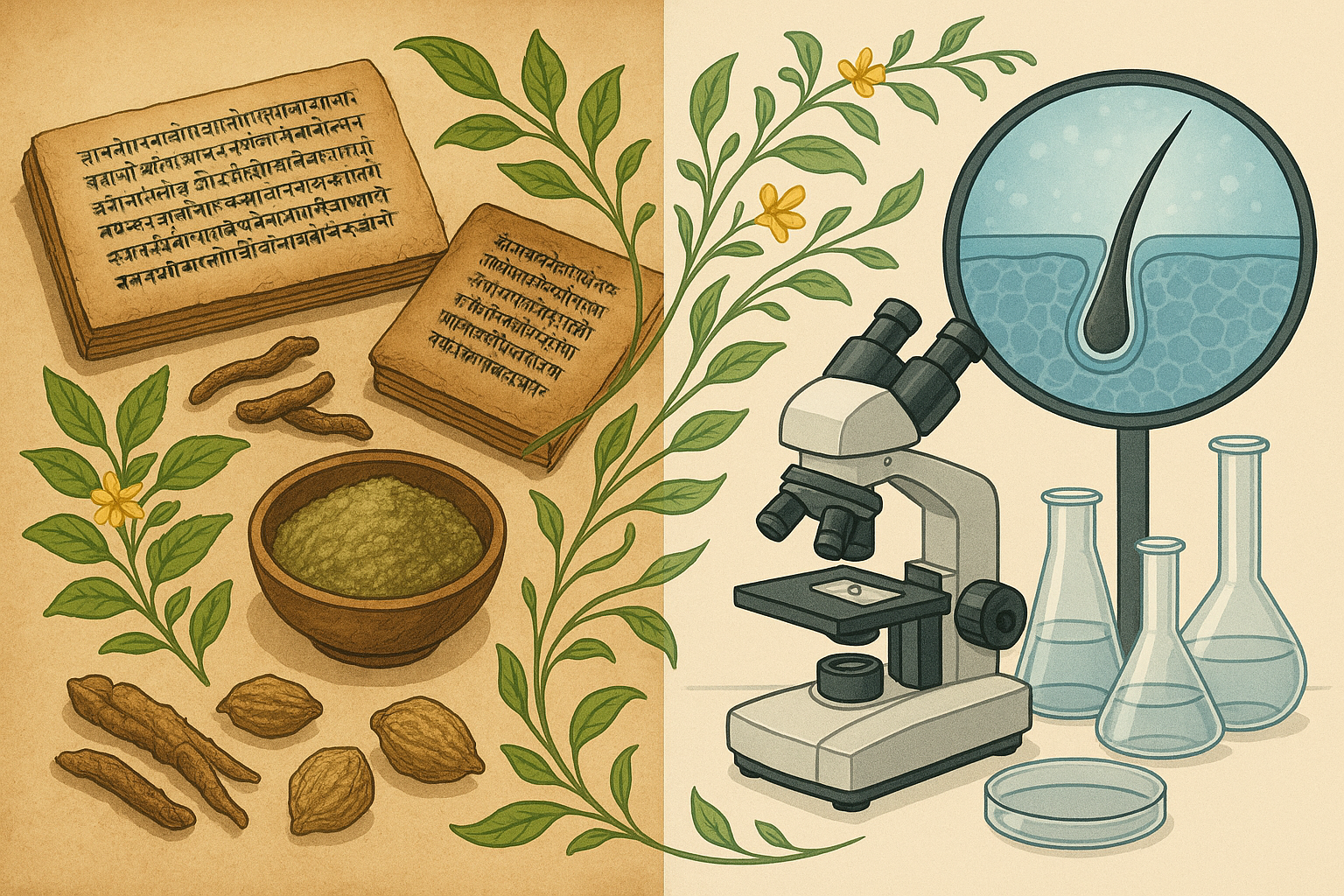
Choosing the Right Ayurvedic Oil for Your Hair Type
Selecting the most suitable Ayurvedic oil requires understanding your unique hair characteristics and specific concerns to achieve optimal results. This personalized approach to hair care ensures that you choose formulations that work harmoniously with your natural constitution and address your individual needs effectively.
Identifying Your Hair Type and Concerns
Begin your assessment by examining your scalp condition throughout the day. An oily scalp typically appears greasy within 24 hours of washing, feels heavy, and may have visible shine at the roots. Conversely, a dry scalp feels tight, may show flaking, and hair appears dull or brittle. Evaluate your hair’s natural texture by running clean fingers through damp hair—fine hair feels silky and lightweight, while coarse hair has more substantial thickness and body.
Observe your hair fall patterns carefully, noting whether strands break mid-length or fall from the roots. Stress related hair fall often manifests as sudden increased shedding during challenging periods, while gradual thinning may indicate nutritional or hormonal factors. Document when hair fall occurs most frequently and any accompanying symptoms like scalp sensitivity or itching.
Oil Recommendations by Hair Type
For dry, damaged hair seeking lustrous hair restoration, coconut-based formulations with herbs like amla and fenugreek provide deep nourishment and moisture retention. These oils penetrate effectively, restoring natural shine and improving overall hair health. Those with an oily scalp benefit from neem-infused oils that regulate sebum production while maintaining scalp cleanliness without over-drying.
Bhringraj-based oils excel for addressing hair fall concerns, particularly when combined with brahmi and methi. These formulations strengthen hair follicles and improve circulation to promote healthy hair growth. For fine or thinning hair, lighter oils like sesame or almond bases prevent weighing down delicate strands while delivering essential nutrients.
Seasonal Considerations
Winter months demand richer, more moisturizing formulations to combat cold, dry air that strips hair of natural oils. Heavier coconut or castor oil bases provide necessary protection and hydration during harsh weather conditions. Summer calls for cooling oils like coconut blended with mint or rose to soothe heated scalps and prevent excessive oil production.
During monsoon or wetter seasons, antifungal properties become crucial for maintaining scalp health in humid conditions. Neem and tea tree oil combinations protect against fungal infections while controlling moisture-related issues. Adjust your oil selection frequency during different seasons—use oils more frequently in winter for extra nourishment, while summer applications may be lighter and less frequent to prevent buildup in humid conditions.
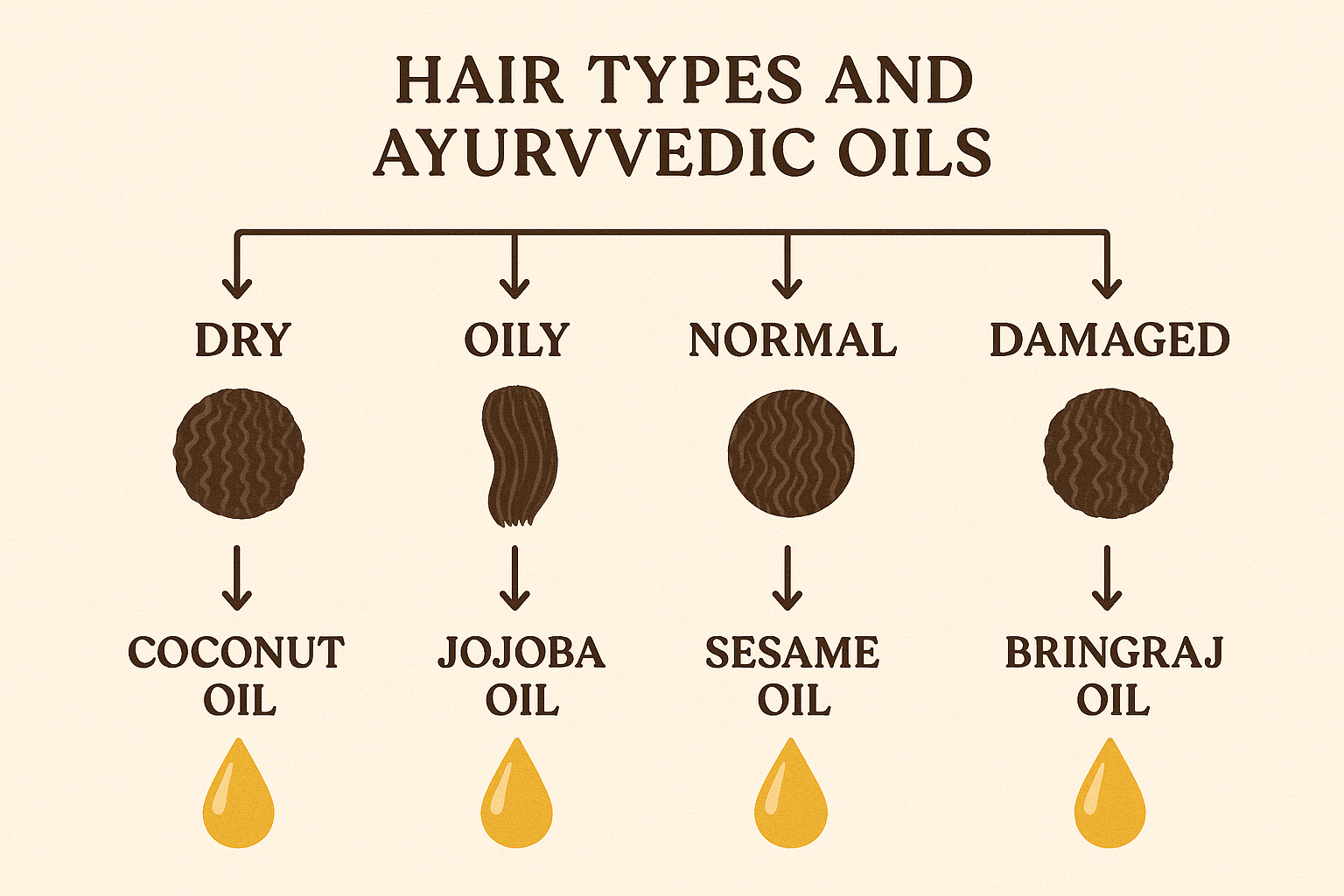
Proper Application Techniques and Rituals
The effectiveness of Ayurvedic hair oils depends significantly on proper application techniques that honor ancient traditions while accommodating modern lifestyles. Mastering these time-tested ayurvedic practices ensures maximum therapeutic benefits and transforms routine hair care into a nurturing ritual that promotes both physical and mental well-being.
Traditional Shiro Abhyanga Method
Shiro abhyanga represents the cornerstone of classical ayurvedic treatment for hair and scalp wellness. This systematic approach begins with gently warming the oil to body temperature, enhancing its penetrative qualities and therapeutic potency. Start by parting the hair into sections, applying oil directly to the scalp using fingertips rather than palms. Work in circular motions from the crown outward, maintaining consistent gentle pressure that stimulates blood circulation without causing discomfort. The traditional technique emphasizes covering every inch of the scalp methodically, ensuring even distribution while avoiding excessive pulling or tugging of hair strands. This ancient ayurvedic ritual should be performed for 10-15 minutes, allowing sufficient time for the oils to penetrate deeply and support scalp health. Traditional practitioners recommend this comprehensive massage 2-3 times weekly for optimal results, though daily application during intensive treatment periods can accelerate healing processes.
Modern Adaptations for Busy Lifestyles
Contemporary ayurvedic practices acknowledge the time constraints of modern living while preserving therapeutic effectiveness. Quick 10-minute applications focus on strategic pressure points around the hairline, temples, and crown, delivering concentrated benefits in minimal time. For overnight treatments, apply oil generously before bedtime, covering with a silk scarf or cotton cloth to protect bedding while allowing extended absorption. Pre-shower routines work exceptionally well for busy schedules – apply oil 30 minutes before washing, creating an effective hair care routine that integrates seamlessly into daily hygiene practices. These adaptations maintain the essence of traditional ayurvedic rituals while respecting time limitations, ensuring consistent application despite hectic lifestyles.
Timing and Frequency Guidelines
Optimal timing varies based on individual constitution, hair condition, and lifestyle factors. Daily light applications work best for maintenance and prevention, while intensive weekly treatments address specific concerns like excessive dryness or thinning. Morning applications energize the system and prepare hair for environmental stressors, whereas evening treatments promote relaxation and overnight healing. Seasonal adjustments enhance effectiveness – increase frequency during dry winter months and reduce during humid summer periods. Those with oily scalps benefit from twice-weekly applications, while dry or damaged hair responds well to every-other-day treatments. Consistency remains more important than frequency in establishing effective ayurvedic practices that support scalp health long-term.
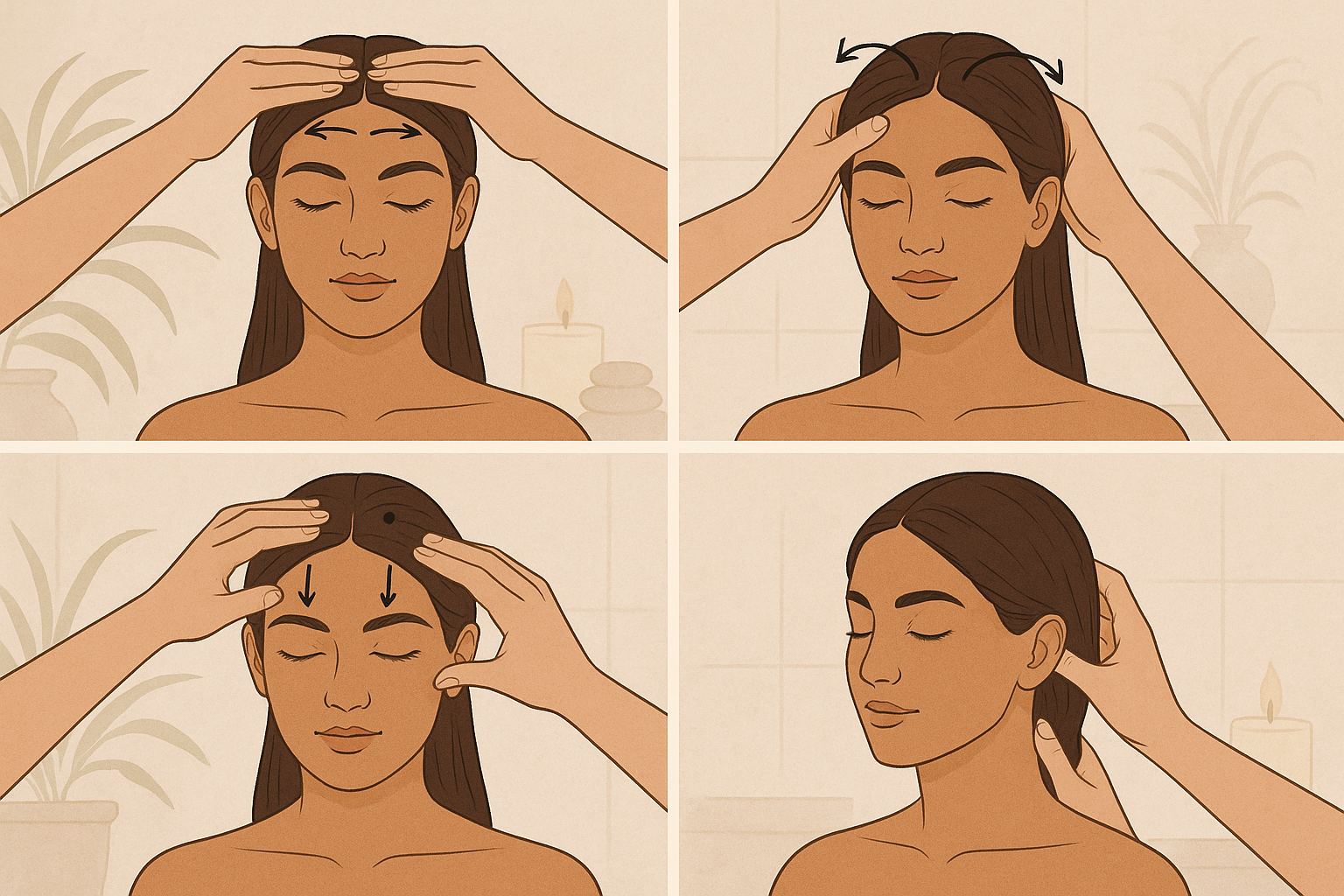
Integrating Ayurvedic Hair Care into Modern Routines
Successfully merging ancient Ayurvedic wisdom with contemporary haircare requires thoughtful planning and strategic timing. Modern lifestyles demand practical approaches that honour traditional practices while accommodating busy schedules and existing product preferences.
Compatibility with Modern Products
Integrating Ayurvedic oils into your existing hair care routine requires understanding product interactions and optimal application timing. Pre-shampoo oil treatments work exceptionally well, allowing the nourishing properties of traditional oils to penetrate deeply before cleansing. Apply your chosen ayurvedic solution 30-60 minutes before washing, giving sufficient time for absorption while avoiding product buildup.
Sulfate-free shampoos complement Ayurvedic treatments better than conventional formulas, as harsh sulfates can strip away beneficial oils too aggressively. These gentler cleansers preserve the nourishing effects of your oil treatment while effectively removing excess product. When selecting conditioners, opt for silicone-free formulations that won’t create barriers preventing future oil absorption.
Timing becomes crucial when combining traditional oils with styling products. Allow hair to dry completely after oil treatments before applying heat protectants or styling aids. This prevents ingredient conflicts and ensures each product performs optimally. Water-based styling products generally work better with oil-treated hair than heavy, oil-based alternatives.
Creating a Balanced Routine
A well-structured weekly schedule seamlessly blends Ayurvedic practices with modern convenience. Dedicate two evenings per week to intensive oil treatments, focusing on scalp massage and deep conditioning. These sessions become your primary ayurveda experience, allowing time for relaxation and thorough application.
Daily care integration involves lighter applications and targeted treatments. Morning routines might include a few drops of oil on damp hair ends, while evening care could feature gentle scalp massage with diluted formulations. This approach maintains consistent nourishment without overwhelming your hair care routine.
Travel-friendly adaptations ensure continuity even when away from home. Pre-mixed oil blends in small containers, dry shampoo alternatives, and simplified application methods help maintain your ayurvedic solution regimen. Consider solid oil bars or leave-in treatments that don’t require extensive preparation time.
Success lies in gradual implementation rather than complete routine overhaul. Start with one or two Ayurvedic elements, observing how your hair responds before expanding your practice. This measured approach helps promote hair health while allowing your scalp and strands to adjust to new ingredients and application methods.
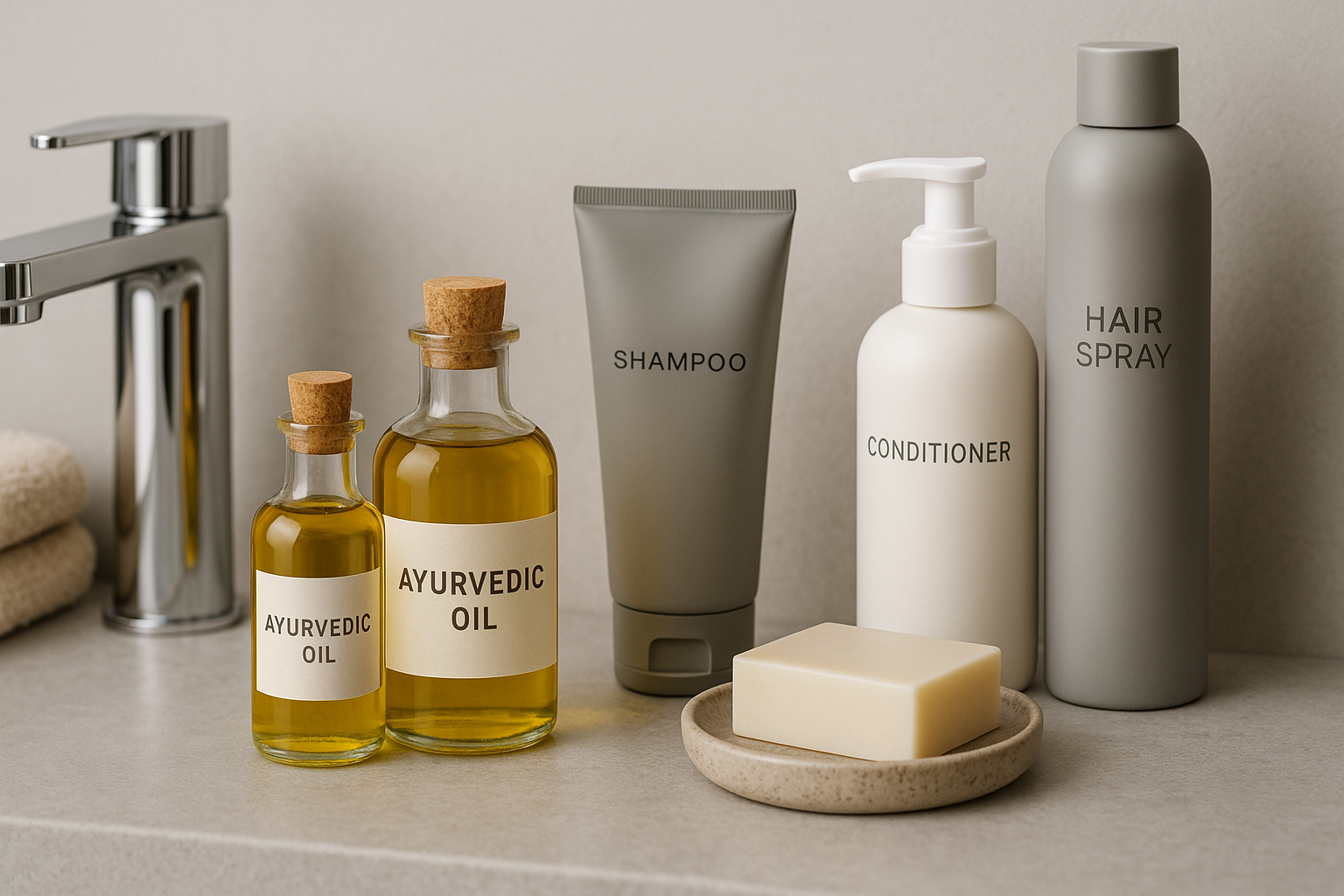
Common Misconceptions and Modern Clarifications
One of the most persistent misconceptions surrounding ayurvedic hair care involves unrealistic expectations about instant results. Many people expect dramatic changes within days or weeks, but modern research confirms that healthy hair growth follows biological timelines, typically requiring 3-6 months for noticeable improvements [5]. Ayurveda teaches patience and consistency, emphasizing that sustainable hair health develops gradually through regular practice rather than quick fixes.
Another widespread myth suggests that ayurvedic oils can reverse genetic hair loss patterns completely. While Ayurveda offers valuable support for overall scalp health and can potentially slow progression, it cannot override strong genetic predispositions to androgenetic alopecia [6]. An experienced ayurvedic practitioner will set realistic expectations, explaining how traditional treatments complement rather than replace modern interventions when necessary.
The misconception that “natural always means harmless” requires careful clarification. Ayurveda emphasizes the importance of proper preparation, dosage, and individual constitution assessment. Some traditional ingredients may cause allergic reactions or interact with medications, making professional guidance essential for safe application.
Many individuals incorrectly assume that ayurvedic treatments work universally for everyone. However, ayurvedic principles recognize that hair concerns manifest differently based on individual dosha imbalances, lifestyle factors, and underlying health conditions. Stress related hair loss, for example, requires different approaches than nutritional deficiencies or hormonal imbalances when viewed through an ayurvedic lens.
Perhaps the most significant misconception involves dismissing ayurvedic practices as unscientific. Modern research increasingly validates many traditional principles, particularly regarding the anti-inflammatory and circulation-enhancing properties of commonly used herbs and oils. However, this doesn’t mean every traditional claim has scientific backing, highlighting the importance of evidence-based practice within ayurvedic frameworks.
Understanding these clarifications helps individuals approach ayurvedic hair care with appropriate expectations, combining traditional wisdom with modern scientific understanding for optimal results. This balanced perspective honors ancient knowledge while acknowledging the limitations and realistic timelines associated with natural healing approaches.
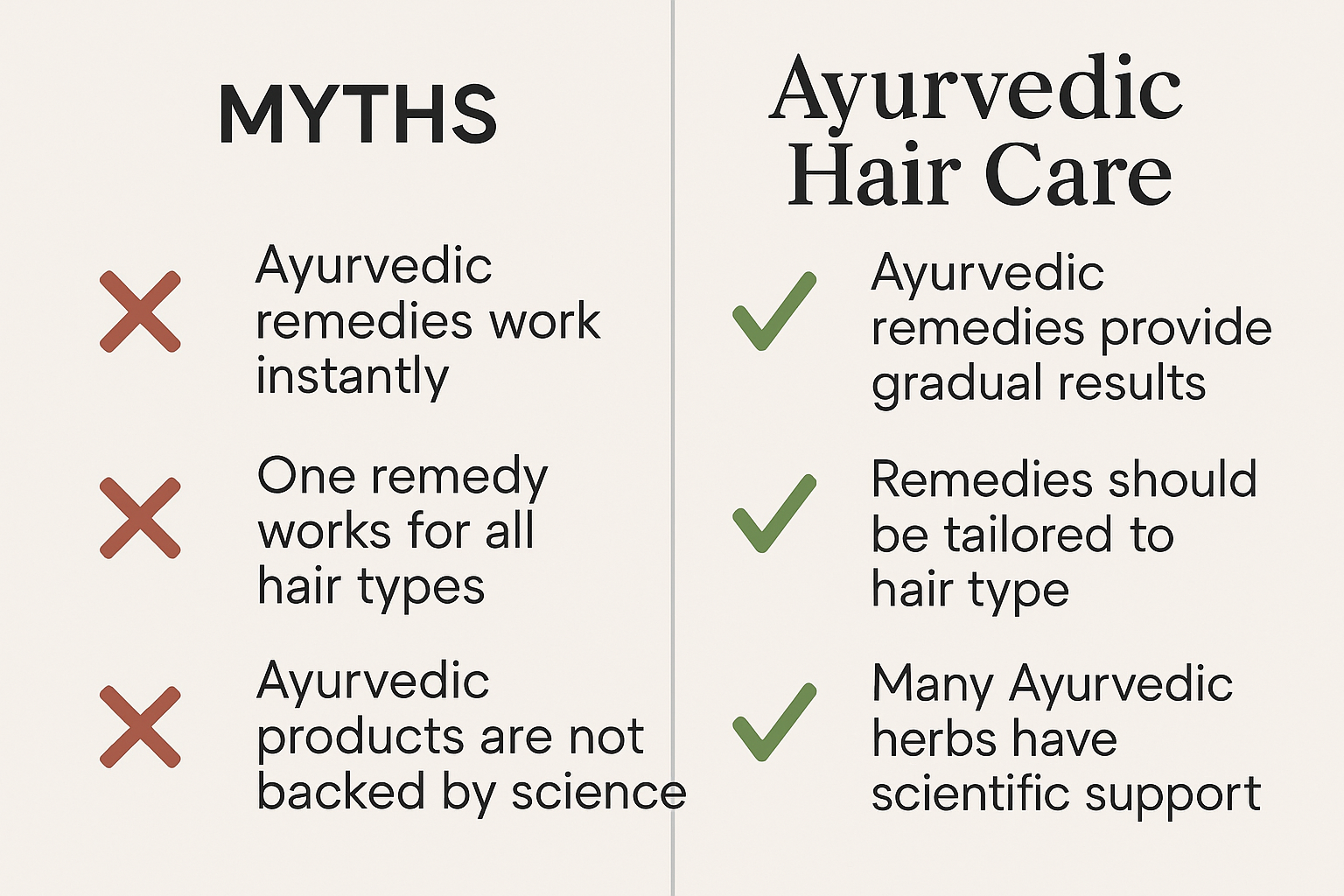
Conclusion
The journey through ayurvedic hair care reveals how ancient wisdom continues to offer profound solutions for modern hair health challenges. By embracing ayurvedic hair oils and traditional remedies, we bridge the gap between time-tested practices and contemporary scientific understanding of scalp biology and hair structure.
The beauty of ayurvedic tradition lies in its holistic approach, addressing not just surface-level concerns but the deeper underlying imbalances that affect overall hair health. These powerful ayurvedic remedies, when applied with proper technique and realistic expectations, can transform your hair care routine from a mundane daily task into a therapeutic ritual that nourishes both body and mind.
As you embark on your ayurvedic hair care journey, remember that consistency and patience are essential virtues in this ancient practice. The ancient wisdom embedded in these time-honored practices developed over millennia, recognizing that true transformation occurs gradually and sustainably over time. Modern research validates many traditional claims, showing how specific botanical ingredients in ayurvedic hair oils support scalp circulation, reduce inflammation, and strengthen hair follicles naturally.
Embrace this powerful fusion of ancient knowledge and modern science, allowing ayurvedic tradition to guide you toward healthier, more vibrant hair while maintaining realistic expectations about timing and sustainable results.
Frequently Asked Questions
Results typically appear after 6-8 weeks of consistent use, with significant improvements visible after 3-4 months of regular application.
While generally safe, some people may be sensitive to specific herbs. Always patch test new oils and consult an Ayurvedic practitioner if you have known allergies.
Price doesn’t always indicate quality. Look for authentic ingredients, proper preparation methods, and reputable sources rather than focusing solely on cost.
References
- Mukherjee PK, Harwansh RK, Bahadur S, Banerjee S, Kar A, Chanda J et al.. Development of Ayurveda - Tradition to trend. J Ethnopharmacol. 2017. PMID: 27633405
- Patwardhan B, Warude D, Pushpangadan P, Bhatt N. Ayurveda and traditional Chinese medicine: a comparative overview. Evid Based Complement Alternat Med. 2005. PMID: 16322803
- Roy RK, Thakur M, Dixit VK. Hair growth promoting activity of Eclipta alba in male albino rats. Arch Dermatol Res. 2008. PMID: 18478241
- Kumar N, Rungseevijitprapa W, Narkkhong NA, Suttajit M, Chaiyasut C. 5α-reductase inhibition and hair growth promotion of some Thai plants traditionally used for hair treatment. J Ethnopharmacol. 2012. PMID: 22178180
- Almohanna HM, Ahmed AA, Tsatalis JP, Tosti A. The Role of Vitamins and Minerals in Hair Loss: A Review. Dermatol Ther (Heidelb). 2019. PMID: 30547302
- Adil A, Godwin M. The effectiveness of treatments for androgenetic alopecia: A systematic review and meta-analysis. J Am Acad Dermatol. 2017. PMID: 28396101

